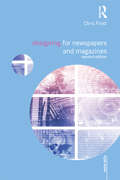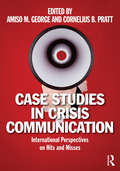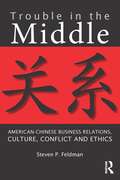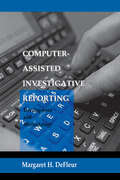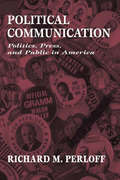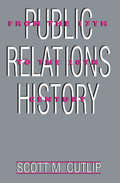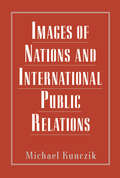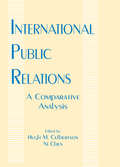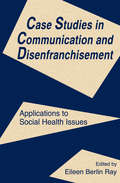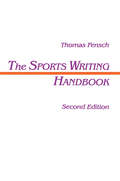- Table View
- List View
Designing for Newspapers and Magazines
by Chris FrostA hugely beneficial introduction to students and professionals in print media and design, Designing for Newspapers and Magazines offers guidance on how to produce attractive publications and how to tailor them to their target audience using colour, text placement, typography and images.Written by an experienced journalist and designer, the book details the elements of good design and provides instruction on how to get the most of computers and computer-aided design.The book examines a broad range of local and national publications including The Sun, The Daily Mirror and Glamour magazine and explains the reasoning that underpins their design choice, including: how to set up a new publication planning an edition of a newspaper or magazine typography and working with text working with images and technical production designing pages and how to use colour design and journalism ethics a glossary of journalistic and design terms
Designing for Newspapers and Magazines
by Chris FrostA hugely beneficial introduction to students and professionals in print media and design, Designing for Newspapers and Magazines offers guidance on how to produce attractive publications and how to tailor them to their target audience using colour, text placement, typography and images.Written by an experienced journalist and designer, the book details the elements of good design and provides instruction on how to get the most of computers and computer-aided design.The book examines a broad range of local and national publications including The Sun, The Daily Mirror and Glamour magazine and explains the reasoning that underpins their design choice, including: how to set up a new publication planning an edition of a newspaper or magazine typography and working with text working with images and technical production designing pages and how to use colour design and journalism ethics a glossary of journalistic and design terms
Case Studies in Crisis Communication: International Perspectives on Hits and Misses
by Amiso M. George Cornelius B. PrattCase Studies in Crisis Communication: International Perspectives on Hits and Misses was created to fill the gap for a much-needed textbook in case studies in crisis communication from international perspectives. The events of September 11, 2001, other major world crises, and the ongoing macroeconomic challenges of financial institutions, justify the need for this book. While existing textbooks on the subject focus on U.S. corporate cases, they may not appeal equally to students and practitioners in other countries, hence the need to analyze cases from the United States and from other world regions. The variety and the international focus of the cases, be they environmental, health or management successes or failures, makes this book more appealing to a wider audience. These cases examine socio-cultural issues associated with responding to a variety of crises.
Case Studies in Crisis Communication: International Perspectives on Hits and Misses
by Amiso M. George Cornelius B. PrattCase Studies in Crisis Communication: International Perspectives on Hits and Misses was created to fill the gap for a much-needed textbook in case studies in crisis communication from international perspectives. The events of September 11, 2001, other major world crises, and the ongoing macroeconomic challenges of financial institutions, justify the need for this book. While existing textbooks on the subject focus on U.S. corporate cases, they may not appeal equally to students and practitioners in other countries, hence the need to analyze cases from the United States and from other world regions. The variety and the international focus of the cases, be they environmental, health or management successes or failures, makes this book more appealing to a wider audience. These cases examine socio-cultural issues associated with responding to a variety of crises.
A Handbook of Media and Communication Research: Qualitative and Quantitative Methodologies
by Klaus Bruhn JensenA Handbook of Media and Communication Research presents qualitative as well as quantitative approaches to the study of media and communication, integrating perspectives from both the social sciences and the humanities. Taking methodology as a strategic level of analysis that joins practical concerns with theoretical issues, the Handbook offers a comprehensive and in-depth review of the field and a set of guidelines for how to think about, plan, and carry out media and communication studies in different social and cultural contexts. The second edition has been thoroughly updated with reference to the development of the internet, mobile, and other digital media. Each chapter addresses shifting configurations of established media organizations, media discourses, and media users in networked practices of communication. The introduction and one further chapter probe changing conceptions on mass and interpersonal, online and offline communication – in research as in everyday life. Three new chapters have been added to exemplify different forms of research employing multiple methods to study multiple media in multiple contexts. List of contributors: Klaus Bruhn Jensen, Barrie Gunter, Rasmus Helles, Annette Hill, Stig Hjarvard, Peter Larsen, Amanda Lotz, Graham Murdock, Horace Newcomb, Paddy Scannell, Lynn Schofield Clark, Kim Christian Schrøder
A Handbook of Media and Communication Research: Qualitative and Quantitative Methodologies
by Klaus Bruhn JensenA Handbook of Media and Communication Research presents qualitative as well as quantitative approaches to the study of media and communication, integrating perspectives from both the social sciences and the humanities. Taking methodology as a strategic level of analysis that joins practical concerns with theoretical issues, the Handbook offers a comprehensive and in-depth review of the field and a set of guidelines for how to think about, plan, and carry out media and communication studies in different social and cultural contexts. The second edition has been thoroughly updated with reference to the development of the internet, mobile, and other digital media. Each chapter addresses shifting configurations of established media organizations, media discourses, and media users in networked practices of communication. The introduction and one further chapter probe changing conceptions on mass and interpersonal, online and offline communication – in research as in everyday life. Three new chapters have been added to exemplify different forms of research employing multiple methods to study multiple media in multiple contexts. List of contributors: Klaus Bruhn Jensen, Barrie Gunter, Rasmus Helles, Annette Hill, Stig Hjarvard, Peter Larsen, Amanda Lotz, Graham Murdock, Horace Newcomb, Paddy Scannell, Lynn Schofield Clark, Kim Christian Schrøder
Trouble in the Middle: American-Chinese Business Relations, Culture, Conflict, and Ethics
by Steven P. FeldmanThis book will help readers better understand the ethical and cultural assumptions that both American and Chinese business cultures bring to business relationships in China. It analyzes the relationships developed between the two cultures, areas where they conflict, and how these conflicts are (or are not) resolved. These relationships are investigated in three stages. The author: describes and interprets American business experience in China describes and interprets Chinese business experience in China, including interaction with Americans compares these two business cultures as they are experienced in China to investigate the relationships between them, centering the cultural analysis on ethical issues. Feldman's thorough research gets to the crux of how American and Chinese executives perceive the ethical and cultural aspects of doing business. The result is a book that will prove helpful to all those looking to expertly navigate Chinese-American business relationships.
Public Journalism and Public Life: Why Telling the News Is Not Enough
by Davis Buzz" MerrittThe original edition of Public Journalism and Public Life, published in 1995, was the first comprehensive argument in favor of public journalism. Designed to focus the discussion about public journalism both within and outside the profession, the book has accomplished its purpose. In the ensuing years, the debate has continued; dozens of newspapers and thousands of journalists have been experimenting with the philosophy, while others still dispute its legitimacy. This larger second edition further develops the philosophy, responds to the arguments against it, outlines how specific principles can be applied, and explains the importance of public deliberation and the role of values in public journalism. Divided into three sections, it can be used as a supplement to the first edition or as a starting point for those being newly introduced to the ideas that have been the subject of debate within the profession and among those interested and involved in civic life at all levels. Section 1 summarizes two major arguments -- why journalism and public life are inseparably bound in success or failure and why the way journalism operates in the current environment fosters failure more often than success. Section 2 looks at the evolution of the profession's culture, its impact on the author's extensive career, and how he grew to believe that substantive change is needed in journalism. Section 3 deals with the implications of public journalism philosophy -- how it requires the application of additional values to daily work, its evolution in the early years and where its current focus should be, plus various questions about the future of cyberspace.
Public Journalism and Public Life: Why Telling the News Is Not Enough
by Davis Buzz" MerrittThe original edition of Public Journalism and Public Life, published in 1995, was the first comprehensive argument in favor of public journalism. Designed to focus the discussion about public journalism both within and outside the profession, the book has accomplished its purpose. In the ensuing years, the debate has continued; dozens of newspapers and thousands of journalists have been experimenting with the philosophy, while others still dispute its legitimacy. This larger second edition further develops the philosophy, responds to the arguments against it, outlines how specific principles can be applied, and explains the importance of public deliberation and the role of values in public journalism. Divided into three sections, it can be used as a supplement to the first edition or as a starting point for those being newly introduced to the ideas that have been the subject of debate within the profession and among those interested and involved in civic life at all levels. Section 1 summarizes two major arguments -- why journalism and public life are inseparably bound in success or failure and why the way journalism operates in the current environment fosters failure more often than success. Section 2 looks at the evolution of the profession's culture, its impact on the author's extensive career, and how he grew to believe that substantive change is needed in journalism. Section 3 deals with the implications of public journalism philosophy -- how it requires the application of additional values to daily work, its evolution in the early years and where its current focus should be, plus various questions about the future of cyberspace.
Computer-assisted Investigative Reporting: Development and Methodology
by Margaret H. DeFleurConducting computer analyses for the purposes of revealing information of significance to the press represents an extension of one of the most important forms of American journalism into the contemporary era of new technologies. Investigative reporting had its start with the establishment of the metropolitan newspaper during the early decades of the 1900s. At the time, it was a continuation of the evolving tradition of freedom of the press that had characterized American political life since colonial times. As it developed, investigative reporting stressed facts rather than the opinions of the editor or reporter. In turn, that tradition had its own intellectual roots. Today, computer-assisted investigative reporting (CAIR) extends that "marketplace of ideas" into systematic examinations of the electronic records of government. In addition, computer analyses of other kinds of information systematically gathered by journalists can provide the press with insights into trends and patterns unlikely to be revealed by other means. This unique volume addresses procedures and issues in investigative journalism that have not been explained in other publications. It sets forth -- for the first time -- a detailed and specific methodology for conducting computer-assisted investigative analyses of both large and small scale electronic records of government and other agencies. That methodology consists of the logic of inquiry, strategies for reaching valid conclusions, and rules for reporting what has been revealed by the analyses to the public in clear ways. Such systematic methodologies are essential in social and other sciences and the development of a counterpart for investigative journalism has been badly needed. That systematic methodology is developed within a context that explains the origin and major characteristics of those elements that have come together in American society to make computer-assisted investigative reporting both possible and increasingly a part of standard newsroom practices. These include the development of traditional investigative journalism, the evolution of computer technology, the use of computers by government to keep records, the legal evolution of freedom of information laws, the rapid adoption of computers in newsrooms, the increasing importance of precision journalism, and the sharp increase in recent times of computer-assisted investigative reporting by American newspapers both large and small. The issues addressed in this book are discussed in a very readable context with an abundance of examples and illustrations drawn from the real world of journalism as it is practiced daily in newsrooms around the country. Explanations of concepts, principles, and procedures are set forth in layperson's terms that require very little in the way of knowledge of computers or statistical methods.
Computer-assisted Investigative Reporting: Development and Methodology
by Margaret H. DeFleurConducting computer analyses for the purposes of revealing information of significance to the press represents an extension of one of the most important forms of American journalism into the contemporary era of new technologies. Investigative reporting had its start with the establishment of the metropolitan newspaper during the early decades of the 1900s. At the time, it was a continuation of the evolving tradition of freedom of the press that had characterized American political life since colonial times. As it developed, investigative reporting stressed facts rather than the opinions of the editor or reporter. In turn, that tradition had its own intellectual roots. Today, computer-assisted investigative reporting (CAIR) extends that "marketplace of ideas" into systematic examinations of the electronic records of government. In addition, computer analyses of other kinds of information systematically gathered by journalists can provide the press with insights into trends and patterns unlikely to be revealed by other means. This unique volume addresses procedures and issues in investigative journalism that have not been explained in other publications. It sets forth -- for the first time -- a detailed and specific methodology for conducting computer-assisted investigative analyses of both large and small scale electronic records of government and other agencies. That methodology consists of the logic of inquiry, strategies for reaching valid conclusions, and rules for reporting what has been revealed by the analyses to the public in clear ways. Such systematic methodologies are essential in social and other sciences and the development of a counterpart for investigative journalism has been badly needed. That systematic methodology is developed within a context that explains the origin and major characteristics of those elements that have come together in American society to make computer-assisted investigative reporting both possible and increasingly a part of standard newsroom practices. These include the development of traditional investigative journalism, the evolution of computer technology, the use of computers by government to keep records, the legal evolution of freedom of information laws, the rapid adoption of computers in newsrooms, the increasing importance of precision journalism, and the sharp increase in recent times of computer-assisted investigative reporting by American newspapers both large and small. The issues addressed in this book are discussed in a very readable context with an abundance of examples and illustrations drawn from the real world of journalism as it is practiced daily in newsrooms around the country. Explanations of concepts, principles, and procedures are set forth in layperson's terms that require very little in the way of knowledge of computers or statistical methods.
Organizational Public Relations: A Political Perspective
by Christopher SpicerPublic relations practitioners are often called upon to help chart their organization's strategic development, thus functioning as managerial decision makers linking the organization to its larger environment. This book is about understanding organizations, especially the role played by organizational decision making in the development and implementation of public relations programs and activities. It emphasizes the ways in which an organization's culture and decision making processes ultimately influence the success or failure of their public relations efforts. The research, case studies, and author's interpretations and suggestions explore the often confusing netherworld of organizational mindsets -- particularly as those world views affect the organization's relations with clients and other stakeholders. Understanding organizational politics is the way to understanding how and why decisions are made by the organization's dominant coalition. The primary goal of this text is to enhance our understanding of the ways in which organizations "work" -- the political process that accompanies organizational decision making. As an instrumental participant in the organizational political process, the public relations practitioner must posess knowledge and understanding of the organization's political process in order to succeed within that organization. Given the need for public relations practitioners to form coalitions, negotiate consensus, and advocate organizational interests, the political system metaphor is most approriate for understanding the relationship between organizational power and organizational public relations. This book, then, "steps back" from a focus solely on the design of public relations programs, and instead examines how the impetus for those programs emerges within the organization as a result of organizational politics in action. Its special features include: * practitioner responses at the end of each chapter providing commentary on the usefulness of the ideas presented; * sidebars from popular sources illustrating theories; * new case studies; * merging of management and organizational theory and research with communication theory and research; * a focus on external stakeholders from both an advocacy and a collaborative frame resulting in the creation of a "collaborative advocacy" framework for external communication; and * an extended examination of ethical considerations pertaining to organizational decision making and communication.
Organizational Public Relations: A Political Perspective
by Christopher SpicerPublic relations practitioners are often called upon to help chart their organization's strategic development, thus functioning as managerial decision makers linking the organization to its larger environment. This book is about understanding organizations, especially the role played by organizational decision making in the development and implementation of public relations programs and activities. It emphasizes the ways in which an organization's culture and decision making processes ultimately influence the success or failure of their public relations efforts. The research, case studies, and author's interpretations and suggestions explore the often confusing netherworld of organizational mindsets -- particularly as those world views affect the organization's relations with clients and other stakeholders. Understanding organizational politics is the way to understanding how and why decisions are made by the organization's dominant coalition. The primary goal of this text is to enhance our understanding of the ways in which organizations "work" -- the political process that accompanies organizational decision making. As an instrumental participant in the organizational political process, the public relations practitioner must posess knowledge and understanding of the organization's political process in order to succeed within that organization. Given the need for public relations practitioners to form coalitions, negotiate consensus, and advocate organizational interests, the political system metaphor is most approriate for understanding the relationship between organizational power and organizational public relations. This book, then, "steps back" from a focus solely on the design of public relations programs, and instead examines how the impetus for those programs emerges within the organization as a result of organizational politics in action. Its special features include: * practitioner responses at the end of each chapter providing commentary on the usefulness of the ideas presented; * sidebars from popular sources illustrating theories; * new case studies; * merging of management and organizational theory and research with communication theory and research; * a focus on external stakeholders from both an advocacy and a collaborative frame resulting in the creation of a "collaborative advocacy" framework for external communication; and * an extended examination of ethical considerations pertaining to organizational decision making and communication.
Manager's Guide to Excellence in Public Relations and Communication Management
by David M. Dozier Larissa A. Grunig James E. GrunigThis book reports findings of a three-nation study of public relations and communication management sponsored by the International Association of Business Communicators (IABC) Research Foundation. The Excellence Study provides communication managers and public relations practitioners with information critical to their own professional growth, and supplies organizations with tools that help them communicate more effectively and build beneficial relations with key publics. Communication excellence is a powerful idea of sweeping scope that applies to all organizations -- large or small -- that need to communicate effectively with publics on whom the organization's survival and growth depend. The essential elements of excellent communication are the same for corporations, not-for-profit organizations, government agencies, and professional/trade associations. And they are applicable on a global basis. The study identifies three spheres of communication excellence. These spheres consider the overall function and role of communication in organizations, and define the organization of this book. They are: * the core or inner sphere of communication excellence -- the knowledge base of the communication department, * the shared expectations of top communicators and senior managers about the function and role of communication, and * the organization's culture -- the larger context that either nurtures or impedes communication excellence. This text also examines communication excellence as demonstrated in specific programs developed for specific publics.
Manager's Guide to Excellence in Public Relations and Communication Management
by David M. Dozier Larissa A. Grunig James E. GrunigThis book reports findings of a three-nation study of public relations and communication management sponsored by the International Association of Business Communicators (IABC) Research Foundation. The Excellence Study provides communication managers and public relations practitioners with information critical to their own professional growth, and supplies organizations with tools that help them communicate more effectively and build beneficial relations with key publics. Communication excellence is a powerful idea of sweeping scope that applies to all organizations -- large or small -- that need to communicate effectively with publics on whom the organization's survival and growth depend. The essential elements of excellent communication are the same for corporations, not-for-profit organizations, government agencies, and professional/trade associations. And they are applicable on a global basis. The study identifies three spheres of communication excellence. These spheres consider the overall function and role of communication in organizations, and define the organization of this book. They are: * the core or inner sphere of communication excellence -- the knowledge base of the communication department, * the shared expectations of top communicators and senior managers about the function and role of communication, and * the organization's culture -- the larger context that either nurtures or impedes communication excellence. This text also examines communication excellence as demonstrated in specific programs developed for specific publics.
Political Communication: Politics, Press, and Public in America
by Richard M. PerloffIn this political communication text, Richard M. Perloff examines the various ways in which messages are constructed and communicated from public officials and politicians through the mass media to the ultimate receivers-the people. With a focus on the history of political communication, he provides an overview of the most significant issues in the study of politics and the media. In addition to synthesizing facts and theories, and highlighting the scholarly contributions made to the understanding of political communication effects, Political Communication addresses such factors as the rhetorical accomplishments of American presidents, the ongoing tangles between the press and the presidency, and the historical roots of politics as it is practiced and studied today. It also addresses major issues about the press and politics that continually resurface, such as question of press bias and the use and manipulation of media by politicians to accomplish national goals. As a comprehensive and engaging introduction to contemporary political communication, this volume provides all readers with a historical perspective on American politics and press and offers a unique appreciation of the strengths and virtues of political communication in America.
Political Communication: Politics, Press, and Public in America
by Richard M. PerloffIn this political communication text, Richard M. Perloff examines the various ways in which messages are constructed and communicated from public officials and politicians through the mass media to the ultimate receivers-the people. With a focus on the history of political communication, he provides an overview of the most significant issues in the study of politics and the media. In addition to synthesizing facts and theories, and highlighting the scholarly contributions made to the understanding of political communication effects, Political Communication addresses such factors as the rhetorical accomplishments of American presidents, the ongoing tangles between the press and the presidency, and the historical roots of politics as it is practiced and studied today. It also addresses major issues about the press and politics that continually resurface, such as question of press bias and the use and manipulation of media by politicians to accomplish national goals. As a comprehensive and engaging introduction to contemporary political communication, this volume provides all readers with a historical perspective on American politics and press and offers a unique appreciation of the strengths and virtues of political communication in America.
Public Relations History: The Antecedents
by Scott M. CutlipThis important volume documents events and routines defined as public relations practice, and serves as a companion work to the author's The Unseen Power: Public Relations which tells the history of public relations as revealed in the work and personalities of the pioneer agencies. This history opens with the 17th Century efforts of land promoters and colonists to lure settlers from Europe -- mainly England -- to this primitive land along the Atlantic Coast. They used publicity, tracts, sermons, and letters to disseminate rosy, glowing accounts of life and opportunity in the new land. The volume closes with a description of the public relations efforts of colleges and other non-profit agencies in the late 19th and early 20th centuries, thus providing a bridge across the century line. This study of the origins of public relations provides helpful insight into its functions, its strengths and weaknesses, and its profound though often unseen impact on our society. Public relations or its equivalents -- propaganda, publicity, public information -- began when mankind started to live together in tribal camps where one's survival depended upon others of the tribe. To function, civilization requires communication, conciliation, consensus, and cooperation -- the bedrock fundamentals of the public relations function. This volume is filled with robust public struggles -- the struggles of which history is made and a nation built: * the work of the Revolutionaries, led by the indomitable Sam Adams, to bring on the War of Independence that gave birth to a New Nation; * the propaganda of Alexander Hamilton, James Madison, and John Jay in the Federalist papers to win ratification of the U.S. Constitution -- prevailing against the propaganda of the AntiFederalists led by Richard Henry Lee; * the battle between the forces of President Andrew Jackson, led by Amos Kendall, and those of Nicholas Biddle and his Bank of the United States which presaged corporate versus government campaigns common today: * the classic presidential campaign of 1896 which pitted pro-Big Business candidate William McKinley against the Populist orator of the Platte, William Jennings Bryan. This book details the antecedents of today's flourishing, influential vocation of public relations whose practitioners -- some 150,000 professionals -- make their case for their clients or their employers in the highly competitive public opinion marketplace.
Public Relations History: The Antecedents
by Scott M. CutlipThis important volume documents events and routines defined as public relations practice, and serves as a companion work to the author's The Unseen Power: Public Relations which tells the history of public relations as revealed in the work and personalities of the pioneer agencies. This history opens with the 17th Century efforts of land promoters and colonists to lure settlers from Europe -- mainly England -- to this primitive land along the Atlantic Coast. They used publicity, tracts, sermons, and letters to disseminate rosy, glowing accounts of life and opportunity in the new land. The volume closes with a description of the public relations efforts of colleges and other non-profit agencies in the late 19th and early 20th centuries, thus providing a bridge across the century line. This study of the origins of public relations provides helpful insight into its functions, its strengths and weaknesses, and its profound though often unseen impact on our society. Public relations or its equivalents -- propaganda, publicity, public information -- began when mankind started to live together in tribal camps where one's survival depended upon others of the tribe. To function, civilization requires communication, conciliation, consensus, and cooperation -- the bedrock fundamentals of the public relations function. This volume is filled with robust public struggles -- the struggles of which history is made and a nation built: * the work of the Revolutionaries, led by the indomitable Sam Adams, to bring on the War of Independence that gave birth to a New Nation; * the propaganda of Alexander Hamilton, James Madison, and John Jay in the Federalist papers to win ratification of the U.S. Constitution -- prevailing against the propaganda of the AntiFederalists led by Richard Henry Lee; * the battle between the forces of President Andrew Jackson, led by Amos Kendall, and those of Nicholas Biddle and his Bank of the United States which presaged corporate versus government campaigns common today: * the classic presidential campaign of 1896 which pitted pro-Big Business candidate William McKinley against the Populist orator of the Platte, William Jennings Bryan. This book details the antecedents of today's flourishing, influential vocation of public relations whose practitioners -- some 150,000 professionals -- make their case for their clients or their employers in the highly competitive public opinion marketplace.
Images of Nations and International Public Relations (Routledge Communication Series)
by Michael KunczikThis volume addresses the importance of images of nations in international relations. One fundamental assumption is that the behavior of states is not the same as that of individuals. States are social systems whose behavior as a rule directly corresponds neither to the motives of their respective leaders nor to those of their populations. However, it is also self-evident that international activities always depend on personal relationships. The studies presented relate to more or less deliberate attempts to induce change in images. Given the interdisciplinary nature of the subject matter, findings made in public relations, advertising research, prejudice research and other fields are also taken into account. Very often it is impossible to distinguish between the image of the nation-state and the images of big enterprises such as Krupp, Ford, or Coca Cola. For this reason, the country of origin effect is also discussed.
International Public Relations: A Comparative Analysis
by Hugh M. Culbertson Ni ChenAs a formal occupation, public relations grew primarily in the United States through much of the twentieth century. In recent years, however, it has spread rapidly throughout the world. Broad outlines on how public relations practices differ from country to country have only recently begun to take shape in scholarly writing about the field. The existing literature on international public relations tends to focus on how those working for western organizations --particularly multi-national corporations--can best practice abroad. Although useful, such writings tend to focus on adaptation of western approaches, not on development of new ones designed specifically for varied sociocultural settings around the world. The editors have produced this book for a number of reasons. There has been tremendous growth in the teaching of public relations around the world--enhancing practice in many countries outside North America. There has also been rapid growth in the number of professors who demand theoretical perspectives which might facilitate a unified comparative analysis across countries and regions. Only a few U.S. universities--six documented in this book--now teach courses formerly called "International Public Relations." However, many professors are going abroad to teach and do research. This suggests increased interest in and a need for courses dealing with international public relations. Furthermore, there is a dearth of literature dealing in depth with international PR, an important component of international communication. This appears to be the first book-length comparative analysis of public relations as practiced in various countries and regions around the world. Although existing books on international PR focus largely on ways in which western practitioners, employers, and clients can operate effectively in other countries, this volume views public relations in each country or region covered from the perspective of practitioners in that country. It contains six chapters designed to provide a theoretical anchor for the 14 country and region analyses. Given the intense interest in public relations education as a factor in professional enhancement, it also discusses issues and practices relating to education.
International Public Relations: A Comparative Analysis
by Hugh M. Culbertson Ni ChenAs a formal occupation, public relations grew primarily in the United States through much of the twentieth century. In recent years, however, it has spread rapidly throughout the world. Broad outlines on how public relations practices differ from country to country have only recently begun to take shape in scholarly writing about the field. The existing literature on international public relations tends to focus on how those working for western organizations --particularly multi-national corporations--can best practice abroad. Although useful, such writings tend to focus on adaptation of western approaches, not on development of new ones designed specifically for varied sociocultural settings around the world. The editors have produced this book for a number of reasons. There has been tremendous growth in the teaching of public relations around the world--enhancing practice in many countries outside North America. There has also been rapid growth in the number of professors who demand theoretical perspectives which might facilitate a unified comparative analysis across countries and regions. Only a few U.S. universities--six documented in this book--now teach courses formerly called "International Public Relations." However, many professors are going abroad to teach and do research. This suggests increased interest in and a need for courses dealing with international public relations. Furthermore, there is a dearth of literature dealing in depth with international PR, an important component of international communication. This appears to be the first book-length comparative analysis of public relations as practiced in various countries and regions around the world. Although existing books on international PR focus largely on ways in which western practitioners, employers, and clients can operate effectively in other countries, this volume views public relations in each country or region covered from the perspective of practitioners in that country. It contains six chapters designed to provide a theoretical anchor for the 14 country and region analyses. Given the intense interest in public relations education as a factor in professional enhancement, it also discusses issues and practices relating to education.
Case Studies in Communication and Disenfranchisement: Applications To Social Health Issues
by Eileen Berlin RaySee blurb for Communication and Disenfranchisement. Books will be promoted together.
Case Studies in Communication and Disenfranchisement: Applications To Social Health Issues
by Eileen Berlin RaySee blurb for Communication and Disenfranchisement. Books will be promoted together.
The Sports Writing Handbook
by Thomas FenschCompletely revised and updated in a second edition, this volume represents the only book ever written that analyzes sports writing and presents it as "exceptional" writing. Other books discuss sports writers as "beat reporters" in one area of journalism, whereas this book shows aspiring sports writers a myriad of techniques to make their writing stand out. It takes the reader through the entire process of sports writing: observation, interviewing techniques, and various structures of articles; types of "leads;" transitions within an article; types of endings; use of statistics; do's and don'ts of sports writing; and many other style and technique points. This text provides over 100 examples of leads drawn from newspapers and magazines throughout the country, and also offers up-to-date examples of sports jargon from virtually every major and minor sport played in the U.S.
